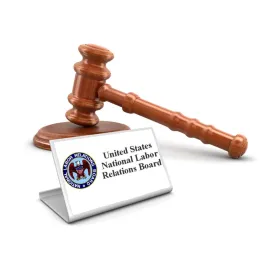On October 21, 2024, the U.S. Court of Appeals for the Ninth Circuit in Cemex Construction Materials Pacific, LLC v. National Labor Relations Board, Case No. 23-2302 (9th Cir.) heard oral argument on the revised National Labor Relations Board (“NLRB” or the “Board”) framework for responding to union organizing, outlined in Cemex Construction Materials Pacific, LLC, 327 NLRB No. 130 (2023) (“Cemex”). The panel of judges consisted of Judges Richard Clifton, Jennifer Sung, and Gabriel Sanchez.
Background
As reported here, Cemex was issued after a line of Board and Supreme Court decisions outlining how a union can become the exclusive representative of the employees in a bargaining unit. These include, among others:
- Joy Silk Mills, Inc., 85 NLRB 1263 (1949) – once a union asserted majority status based on authorization cards, the burden of proof rested with the employer to demonstrate that it had a “good faith doubt” as to the union’s majority status;
- NLRB v. Gissel Packing Co., 395 U.S. 575 (1969) – holding that a bargaining order without an election is appropriate where a union has achieved majority support and an employer engages in unfair labor practices that “have the tendency to undermine majority strength and impede the election processes”; and
- Linden Lumber Div. v. NLRB, 419 U.S. 301 (1974) – overruling Joy Silk and abandoning the “good faith doubt” test, ruling that when confronted with authorization cards purportedly signed by a majority of employees, an employer could reject the cards and insist on a Board-conducted election—even without reason to do so—prior to engaging in bargaining.
In Cemex, the Board overruled Linden Lumber, and created a new, retroactive standard establishing that an employer violates Section 8(a)(5) and (1) of the National Labor Relations Act (“NLRA”) by refusing to recognize, upon request, a union that has been designated as Section 9(a) representative by the majority of employees in an appropriate unit unless the employer “promptly” (within two [2] weeks of the union’s demand for recognition) files an RM Petition to test the union’s majority status or the appropriateness of the unit, assuming that the union has not already filed an RC Petition seeking an election.
In addition, the Board announced a new tool in its arsenal to issue bargaining orders for unlawful conduct by employers during an election. According to the Board, in Cemex, after an RM or RC petition is filed, “if an employer subsequently commits an unfair labor practice that requires setting aside the election, the petition…will be dismissed, and the employer will be subject to a remedial bargaining order.” The Board held that an election must be set aside, and a bargaining order issued for an unfair labor practice charge committed during the period leading up to an election, unless it is “virtually impossible to conclude that the misconduct has affected the outcome of the election.” This standard is much lower than that under Gissel for issuing a pre-election bargaining order, and we have seen ALJs and the Board actively enforce this new standard since the Cemex decision was issued (see here and here).
Ninth Circuit Oral Argument
During the oral argument, the Court focused on the Board’s creation of a new standard for bargaining orders in Cemex, with the merits of the unfair labor practice charge(s) having a peripheral role in the proceedings. The judges were most concerned with (1) whether a bargaining order could have been issued under Gissel alone, potentially obviating the need for a new standard; and (2) whether the Board had the authority to implement this new standard.
During oral argument, Judges Jennifer Sung and Gabriel Sanchez (both Biden appointees) pushed back on the Cemex attorney’s argument that a bargaining order was improper even under Gissel. Both judges alluded to the fact that the Board’s order was being reviewed for an abuse of discretion, and that the allegedly widespread and severe unfair labor practices could have justified a Gissel bargaining order, even if it was a close case. Judge Richard Clifton (George W. Bush appointee) was not as convinced, suggesting that the Board was unsure of whether it had the authority to issue a Gissel bargaining order under the facts presented, and thought, if it did not have the authority, it would “change the rules.”
Most of the remaining exchanges during oral argument concerned the Board’s authority and purported need to implement the new Cemex standard, given the facts of the case. Judges Sung and Sanchez again questioned Cemex’s position on this issue, inquiring as to whether Gissel is the exclusive standard to issue bargaining orders and whether Cemex bargaining orders could exist independent of Gissel. Cemex’s attorney responded that the Supreme Court in Gissel had deemed certain unfair labor practices during an election process to be insufficient to issue a bargaining order, and that the Board in Cemex had “no right” to lower that standard. When faced with similar questioning, the Teamsters attorney and NLRB attorney both characterized Gissel as outlining one permissible scenario for issuing a pre-election bargaining order, but not the only such instance. The NLRB attorney also asserted that the “central holding in Gissel is that non-election proof of majority status is sufficient…to establish an enforceable bargaining obligation.”
In addition to the pre-election unfair labor practice issue, Judge Clifton seemed to view the portion of the Cemex holding essentially requiring employers to file RM petitions if presented with a request for voluntary recognition with skepticism, stating that it was “clearly not the law” for the Board to issue “bargaining order(s) after a failure to respond [to a demand for recognition].” Judge Clifton also had significant criticisms of the Board’s characterization of the Administrative Law Judge (“ALJ”) opinion in Cemex. The Board in Cemex indicated that it “agree[d] with the [ALJ] that the possibility of…ensuring a fair rerun election by the use of the Board’s traditional remedies is slight.” (Emphasis added.) However, Judge Clifton highlighted that this language was never used by the ALJ, who held to the contrary that mitigating circumstances advised against issuing a bargaining order, despite the alleged unfair labor practices. In light of this inconsistency, Judge Clifton asked both the Teamsters attorney and the NLRB attorney on multiple occasions why the Board mischaracterized the ALJ opinion. The attorneys responded by referencing sections of the ALJ opinion that supported the existence of widespread unfair labor practices or arguing that the Board still substantiated its position that a bargaining order was warranted, “even assuming the Board misstated” its reference to the ALJ opinion. Judge Clifton was wholly unsatisfied with their respective responses.
Judge Clifton also highlighted a potential conflict with the Board’s position that (i) it had enough evidence to issue a bargaining order under Gissel but (ii) felt the need to change the framework for pre-election bargaining orders, which Judge Clifton stated was “not necessary to resolve the case.” As a result, Judge Clifton hinted that the Board was arbitrarily exercising regulatory power in creating a new standard, which should have been done through rulemaking. In response, the NLRB attorney maintained that the case presented a need for a change in the law to better remedy pre-election unfair labor practices, and that the Board was permissibly creating and applying an “alternative rationale” for a bargaining order, essentially issuing “two [separate] bargaining orders.”
The NLRB attorney, through questioning by Judge Sung and Sanchez, was also given the opportunity to outline the Board’s authority to issue new standards absent rulemaking. Notably, Judge Sung asked whether the Board used rulemaking to move from “pre-Joy Silk, to Joy-Silk, Linden Lumber,” which the NLRB attorney responded to in the negative. This seemed to hint that
Judge Sung believed the new Cemex standard could be issued through adjudication rather than rulemaking.
Takeaways
It is difficult to predict the outcome of an appellate court proceeding based solely on the questions posed by the judges. Appellate judges may pose questions that seem skeptical of a side’s position in order to elicit a response from the party, but that may not necessarily indicate how the judge will rule on the case. Nevertheless, based on their questions, Judges Sung and Sanchez seemed more skeptical of Cemex’s position and more favorable of the NLRB’s decision, while Judge Clifton appeared to have a different view. If those views are consistent with how the judges decide the case, the Ninth Circuit may affirm the Board’s decision in Cemex, and Judge Clifton may offer a dissenting opinion.
Given the transformative nature of the Cemex decision, and the potential conflict with Supreme Court authority, it is likely that the party on the losing end of the appeal may seek certiorari from the U.S. Supreme Court.
Regardless, even if the Ninth Circuit reverses the Cemex decision, we expect the NLRB to continue to take the position that the holding on appeal is limited to the facts of that particular case, and that the new standard espoused in Cemex remains the law—until it is reversed by the Supreme Court or subsequent NLRB precedent.
As always, we will continue to update you on these developments.



 />i
/>i
